Healthcare Technology: Standards, Regulations, and Management
VerifiedAdded on 2022/10/10
|5
|1268
|285
Report
AI Summary
This report delves into the critical aspects of healthcare technology management, focusing on the interplay of standards and regulations. It explores how these elements support the quality, safety, and effectiveness of medical equipment, impacting healthcare services and technology management. The report highlights the role of standards in evaluating the performance of medical devices, ensuring safety, and facilitating global compatibility. It also discusses the significance of regulations, legal requirements, and international collaborations, such as the International Medical Device Regulators Forum (IMDRF), in shaping the design, safety, and marketing of medical devices. The report emphasizes the importance of understanding these regulatory frameworks for clinical engineers, influencing strategic decisions related to purchasing and design within healthcare settings. The report references key standards like ISO 16142-1 and IEC standards, alongside regulatory bodies to provide a comprehensive overview of healthcare technology management.
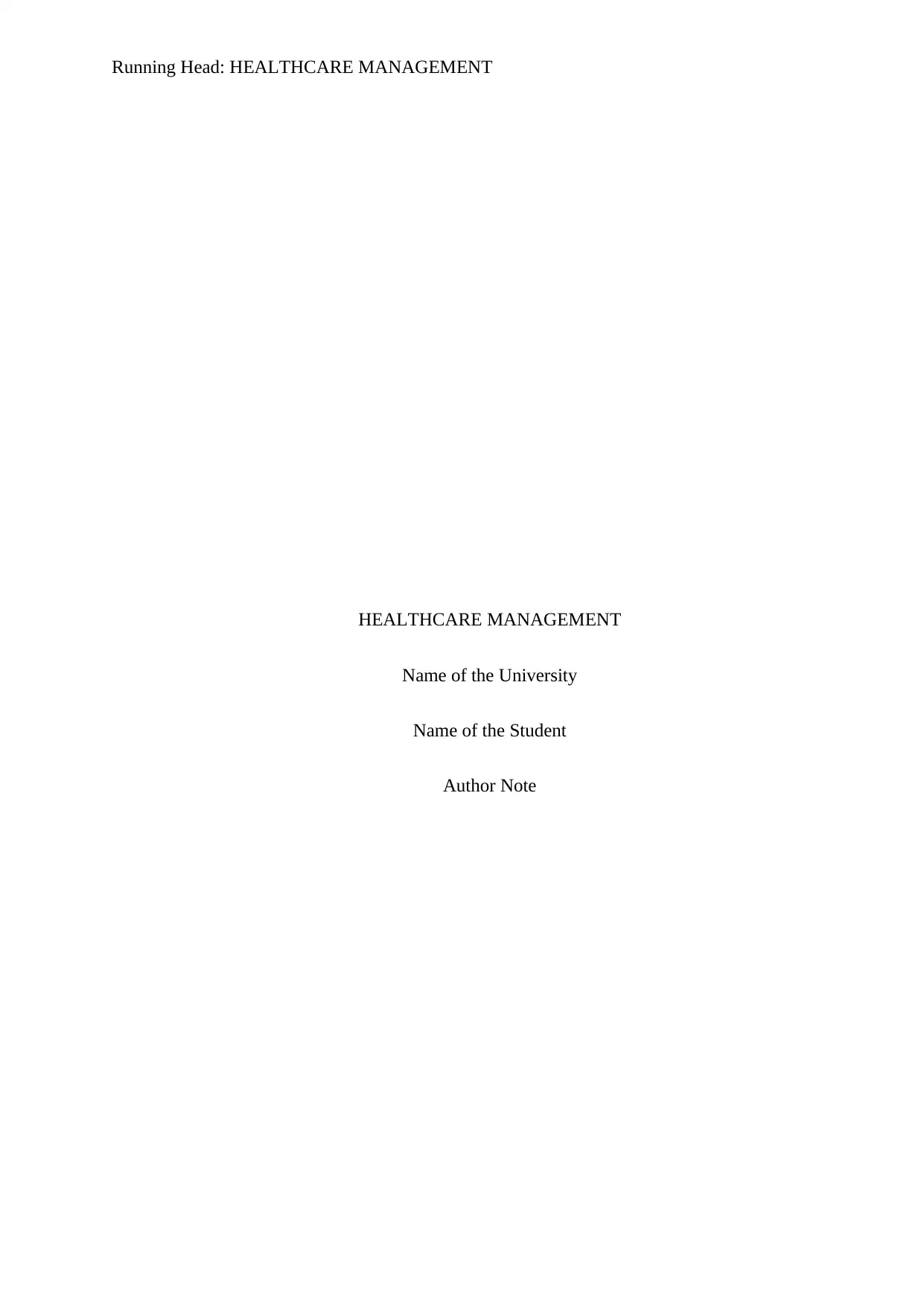
Running Head: HEALTHCARE MANAGEMENT
HEALTHCARE MANAGEMENT
Name of the University
Name of the Student
Author Note
HEALTHCARE MANAGEMENT
Name of the University
Name of the Student
Author Note
Paraphrase This Document
Need a fresh take? Get an instant paraphrase of this document with our AI Paraphraser
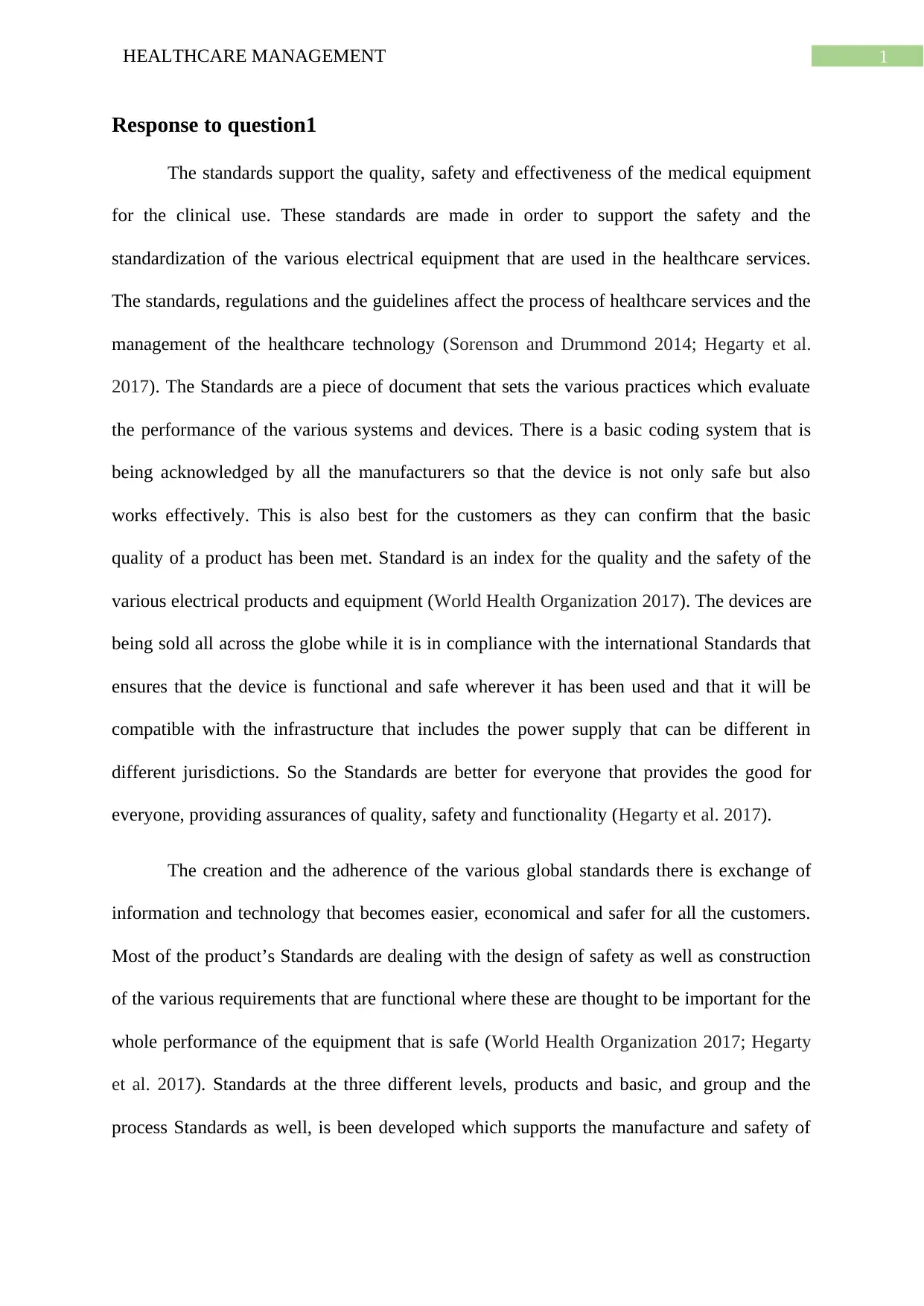
1HEALTHCARE MANAGEMENT
Response to question1
The standards support the quality, safety and effectiveness of the medical equipment
for the clinical use. These standards are made in order to support the safety and the
standardization of the various electrical equipment that are used in the healthcare services.
The standards, regulations and the guidelines affect the process of healthcare services and the
management of the healthcare technology (Sorenson and Drummond 2014; Hegarty et al.
2017). The Standards are a piece of document that sets the various practices which evaluate
the performance of the various systems and devices. There is a basic coding system that is
being acknowledged by all the manufacturers so that the device is not only safe but also
works effectively. This is also best for the customers as they can confirm that the basic
quality of a product has been met. Standard is an index for the quality and the safety of the
various electrical products and equipment (World Health Organization 2017). The devices are
being sold all across the globe while it is in compliance with the international Standards that
ensures that the device is functional and safe wherever it has been used and that it will be
compatible with the infrastructure that includes the power supply that can be different in
different jurisdictions. So the Standards are better for everyone that provides the good for
everyone, providing assurances of quality, safety and functionality (Hegarty et al. 2017).
The creation and the adherence of the various global standards there is exchange of
information and technology that becomes easier, economical and safer for all the customers.
Most of the product’s Standards are dealing with the design of safety as well as construction
of the various requirements that are functional where these are thought to be important for the
whole performance of the equipment that is safe (World Health Organization 2017; Hegarty
et al. 2017). Standards at the three different levels, products and basic, and group and the
process Standards as well, is been developed which supports the manufacture and safety of
Response to question1
The standards support the quality, safety and effectiveness of the medical equipment
for the clinical use. These standards are made in order to support the safety and the
standardization of the various electrical equipment that are used in the healthcare services.
The standards, regulations and the guidelines affect the process of healthcare services and the
management of the healthcare technology (Sorenson and Drummond 2014; Hegarty et al.
2017). The Standards are a piece of document that sets the various practices which evaluate
the performance of the various systems and devices. There is a basic coding system that is
being acknowledged by all the manufacturers so that the device is not only safe but also
works effectively. This is also best for the customers as they can confirm that the basic
quality of a product has been met. Standard is an index for the quality and the safety of the
various electrical products and equipment (World Health Organization 2017). The devices are
being sold all across the globe while it is in compliance with the international Standards that
ensures that the device is functional and safe wherever it has been used and that it will be
compatible with the infrastructure that includes the power supply that can be different in
different jurisdictions. So the Standards are better for everyone that provides the good for
everyone, providing assurances of quality, safety and functionality (Hegarty et al. 2017).
The creation and the adherence of the various global standards there is exchange of
information and technology that becomes easier, economical and safer for all the customers.
Most of the product’s Standards are dealing with the design of safety as well as construction
of the various requirements that are functional where these are thought to be important for the
whole performance of the equipment that is safe (World Health Organization 2017; Hegarty
et al. 2017). Standards at the three different levels, products and basic, and group and the
process Standards as well, is been developed which supports the manufacture and safety of
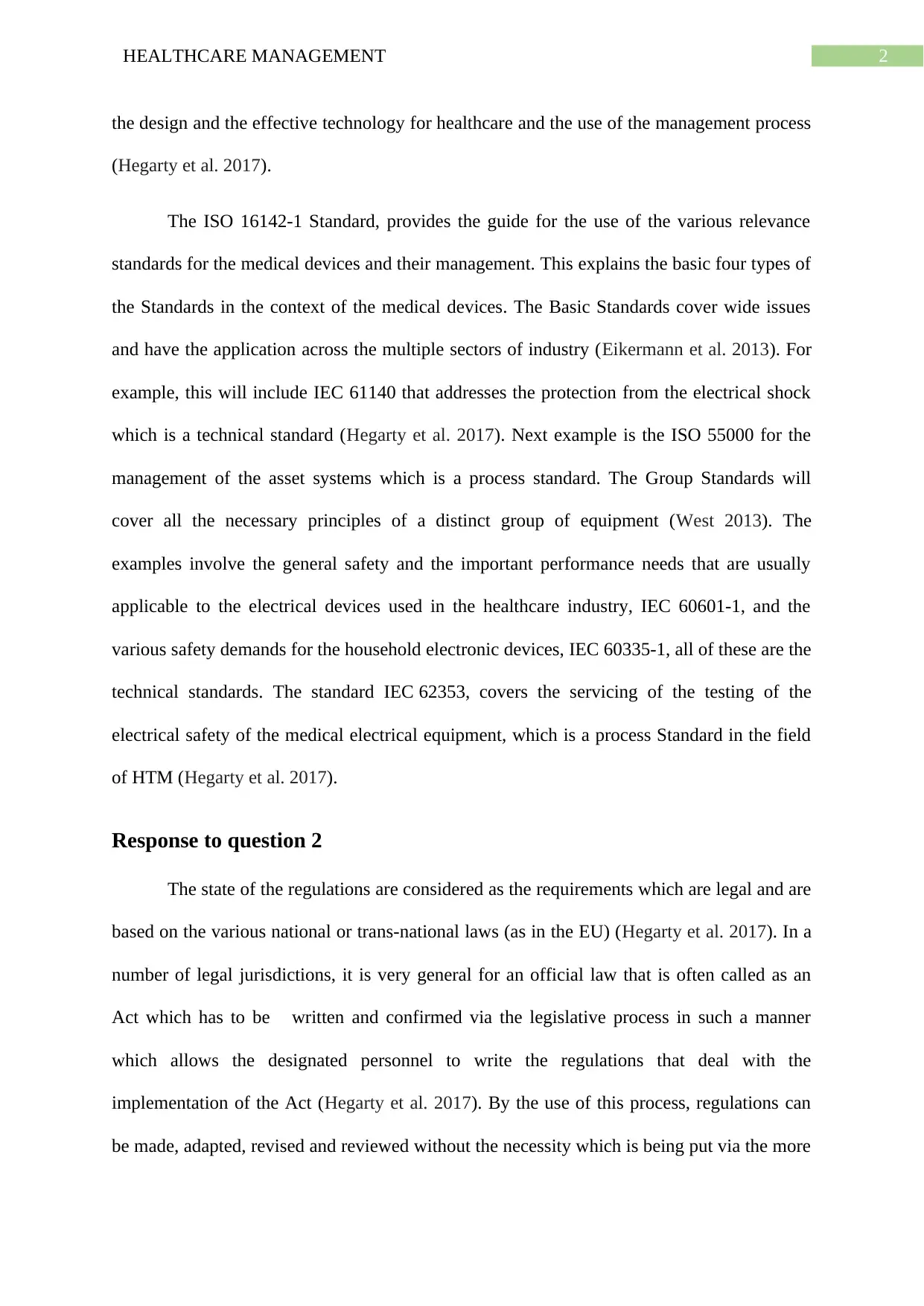
2HEALTHCARE MANAGEMENT
the design and the effective technology for healthcare and the use of the management process
(Hegarty et al. 2017).
The ISO 16142-1 Standard, provides the guide for the use of the various relevance
standards for the medical devices and their management. This explains the basic four types of
the Standards in the context of the medical devices. The Basic Standards cover wide issues
and have the application across the multiple sectors of industry (Eikermann et al. 2013). For
example, this will include IEC 61140 that addresses the protection from the electrical shock
which is a technical standard (Hegarty et al. 2017). Next example is the ISO 55000 for the
management of the asset systems which is a process standard. The Group Standards will
cover all the necessary principles of a distinct group of equipment (West 2013). The
examples involve the general safety and the important performance needs that are usually
applicable to the electrical devices used in the healthcare industry, IEC 60601-1, and the
various safety demands for the household electronic devices, IEC 60335-1, all of these are the
technical standards. The standard IEC 62353, covers the servicing of the testing of the
electrical safety of the medical electrical equipment, which is a process Standard in the field
of HTM (Hegarty et al. 2017).
Response to question 2
The state of the regulations are considered as the requirements which are legal and are
based on the various national or trans-national laws (as in the EU) (Hegarty et al. 2017). In a
number of legal jurisdictions, it is very general for an official law that is often called as an
Act which has to be written and confirmed via the legislative process in such a manner
which allows the designated personnel to write the regulations that deal with the
implementation of the Act (Hegarty et al. 2017). By the use of this process, regulations can
be made, adapted, revised and reviewed without the necessity which is being put via the more
the design and the effective technology for healthcare and the use of the management process
(Hegarty et al. 2017).
The ISO 16142-1 Standard, provides the guide for the use of the various relevance
standards for the medical devices and their management. This explains the basic four types of
the Standards in the context of the medical devices. The Basic Standards cover wide issues
and have the application across the multiple sectors of industry (Eikermann et al. 2013). For
example, this will include IEC 61140 that addresses the protection from the electrical shock
which is a technical standard (Hegarty et al. 2017). Next example is the ISO 55000 for the
management of the asset systems which is a process standard. The Group Standards will
cover all the necessary principles of a distinct group of equipment (West 2013). The
examples involve the general safety and the important performance needs that are usually
applicable to the electrical devices used in the healthcare industry, IEC 60601-1, and the
various safety demands for the household electronic devices, IEC 60335-1, all of these are the
technical standards. The standard IEC 62353, covers the servicing of the testing of the
electrical safety of the medical electrical equipment, which is a process Standard in the field
of HTM (Hegarty et al. 2017).
Response to question 2
The state of the regulations are considered as the requirements which are legal and are
based on the various national or trans-national laws (as in the EU) (Hegarty et al. 2017). In a
number of legal jurisdictions, it is very general for an official law that is often called as an
Act which has to be written and confirmed via the legislative process in such a manner
which allows the designated personnel to write the regulations that deal with the
implementation of the Act (Hegarty et al. 2017). By the use of this process, regulations can
be made, adapted, revised and reviewed without the necessity which is being put via the more
⊘ This is a preview!⊘
Do you want full access?
Subscribe today to unlock all pages.

Trusted by 1+ million students worldwide
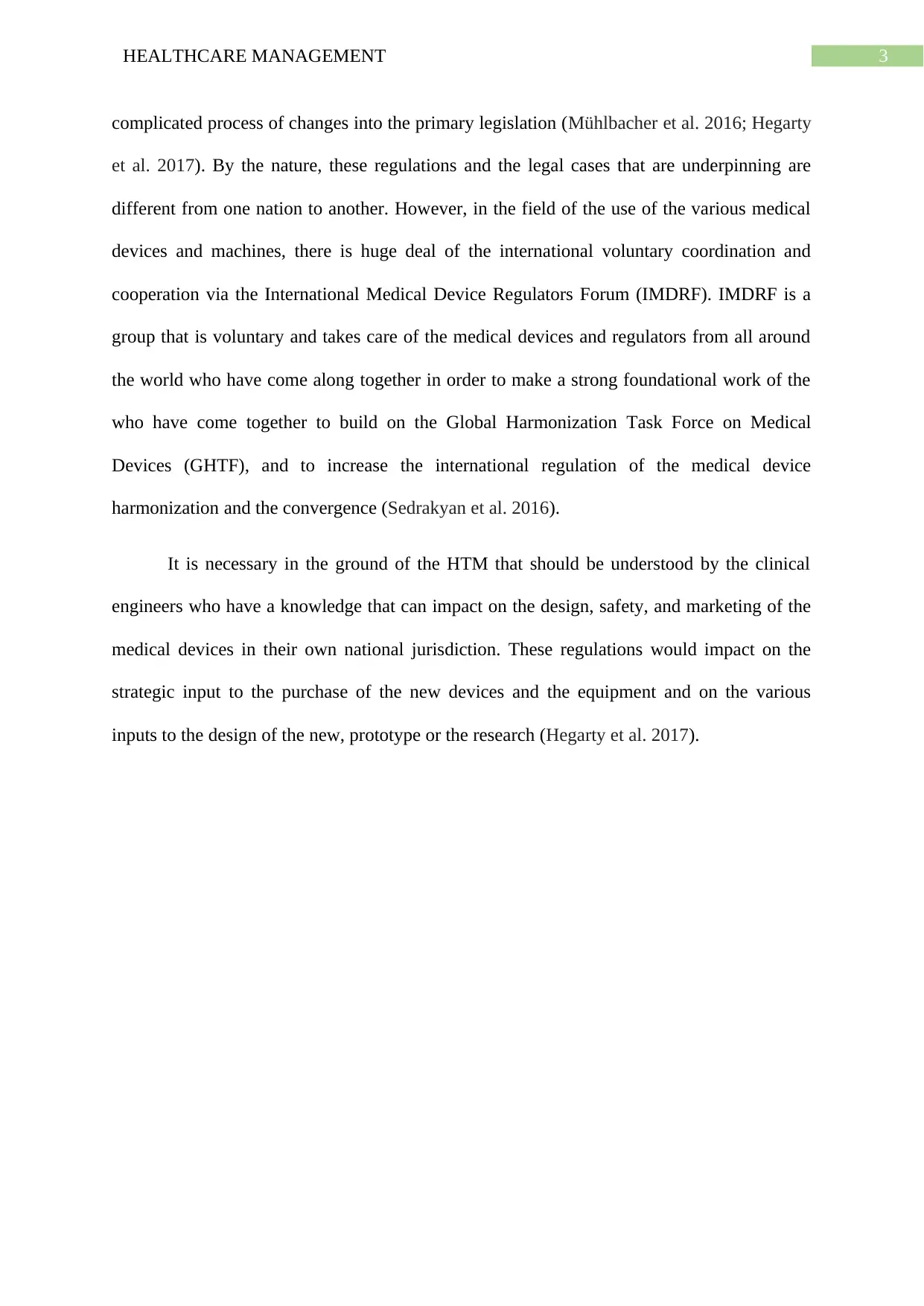
3HEALTHCARE MANAGEMENT
complicated process of changes into the primary legislation (Mühlbacher et al. 2016; Hegarty
et al. 2017). By the nature, these regulations and the legal cases that are underpinning are
different from one nation to another. However, in the field of the use of the various medical
devices and machines, there is huge deal of the international voluntary coordination and
cooperation via the International Medical Device Regulators Forum (IMDRF). IMDRF is a
group that is voluntary and takes care of the medical devices and regulators from all around
the world who have come along together in order to make a strong foundational work of the
who have come together to build on the Global Harmonization Task Force on Medical
Devices (GHTF), and to increase the international regulation of the medical device
harmonization and the convergence (Sedrakyan et al. 2016).
It is necessary in the ground of the HTM that should be understood by the clinical
engineers who have a knowledge that can impact on the design, safety, and marketing of the
medical devices in their own national jurisdiction. These regulations would impact on the
strategic input to the purchase of the new devices and the equipment and on the various
inputs to the design of the new, prototype or the research (Hegarty et al. 2017).
complicated process of changes into the primary legislation (Mühlbacher et al. 2016; Hegarty
et al. 2017). By the nature, these regulations and the legal cases that are underpinning are
different from one nation to another. However, in the field of the use of the various medical
devices and machines, there is huge deal of the international voluntary coordination and
cooperation via the International Medical Device Regulators Forum (IMDRF). IMDRF is a
group that is voluntary and takes care of the medical devices and regulators from all around
the world who have come along together in order to make a strong foundational work of the
who have come together to build on the Global Harmonization Task Force on Medical
Devices (GHTF), and to increase the international regulation of the medical device
harmonization and the convergence (Sedrakyan et al. 2016).
It is necessary in the ground of the HTM that should be understood by the clinical
engineers who have a knowledge that can impact on the design, safety, and marketing of the
medical devices in their own national jurisdiction. These regulations would impact on the
strategic input to the purchase of the new devices and the equipment and on the various
inputs to the design of the new, prototype or the research (Hegarty et al. 2017).
Paraphrase This Document
Need a fresh take? Get an instant paraphrase of this document with our AI Paraphraser
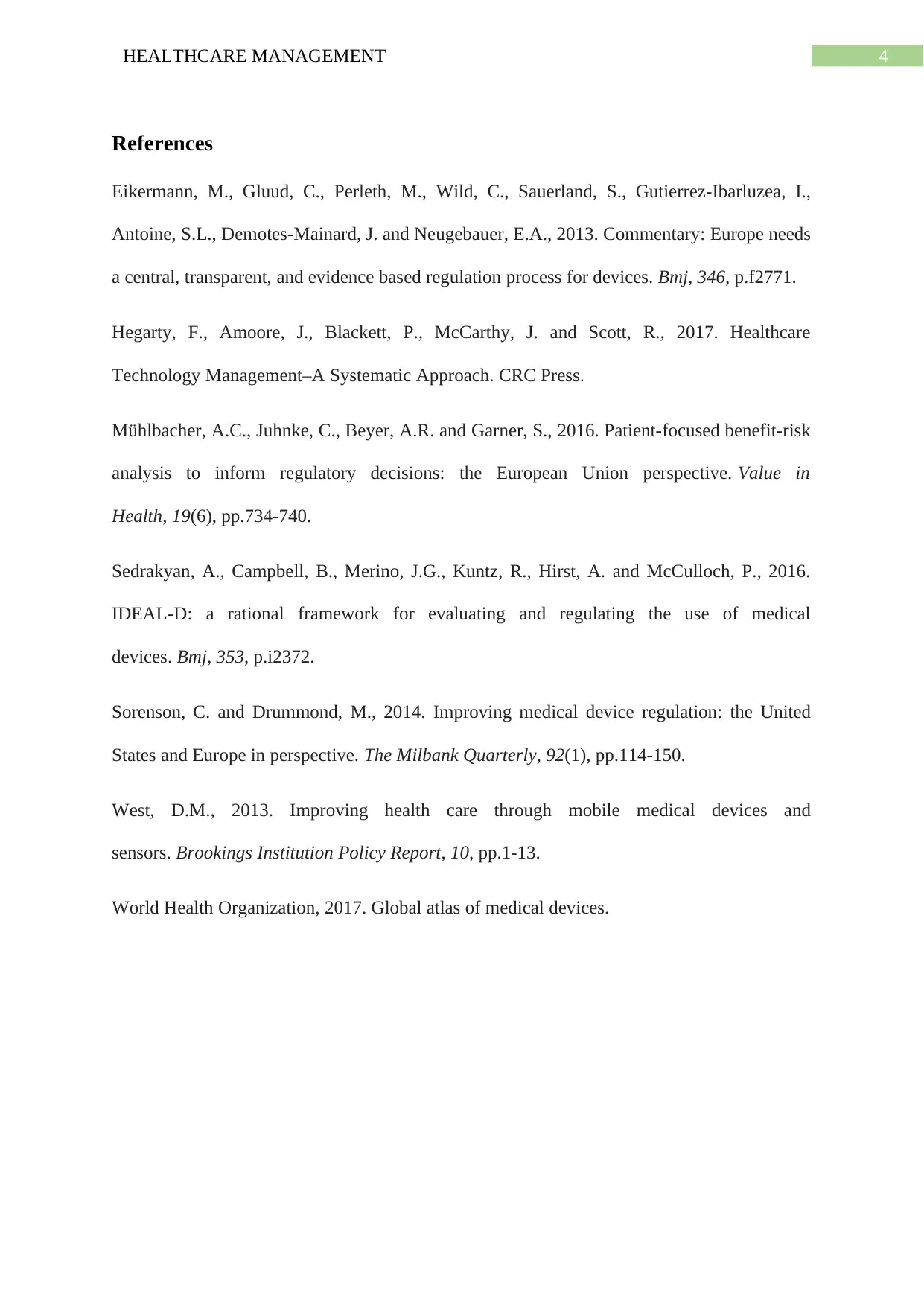
4HEALTHCARE MANAGEMENT
References
Eikermann, M., Gluud, C., Perleth, M., Wild, C., Sauerland, S., Gutierrez-Ibarluzea, I.,
Antoine, S.L., Demotes-Mainard, J. and Neugebauer, E.A., 2013. Commentary: Europe needs
a central, transparent, and evidence based regulation process for devices. Bmj, 346, p.f2771.
Hegarty, F., Amoore, J., Blackett, P., McCarthy, J. and Scott, R., 2017. Healthcare
Technology Management–A Systematic Approach. CRC Press.
Mühlbacher, A.C., Juhnke, C., Beyer, A.R. and Garner, S., 2016. Patient-focused benefit-risk
analysis to inform regulatory decisions: the European Union perspective. Value in
Health, 19(6), pp.734-740.
Sedrakyan, A., Campbell, B., Merino, J.G., Kuntz, R., Hirst, A. and McCulloch, P., 2016.
IDEAL-D: a rational framework for evaluating and regulating the use of medical
devices. Bmj, 353, p.i2372.
Sorenson, C. and Drummond, M., 2014. Improving medical device regulation: the United
States and Europe in perspective. The Milbank Quarterly, 92(1), pp.114-150.
West, D.M., 2013. Improving health care through mobile medical devices and
sensors. Brookings Institution Policy Report, 10, pp.1-13.
World Health Organization, 2017. Global atlas of medical devices.
References
Eikermann, M., Gluud, C., Perleth, M., Wild, C., Sauerland, S., Gutierrez-Ibarluzea, I.,
Antoine, S.L., Demotes-Mainard, J. and Neugebauer, E.A., 2013. Commentary: Europe needs
a central, transparent, and evidence based regulation process for devices. Bmj, 346, p.f2771.
Hegarty, F., Amoore, J., Blackett, P., McCarthy, J. and Scott, R., 2017. Healthcare
Technology Management–A Systematic Approach. CRC Press.
Mühlbacher, A.C., Juhnke, C., Beyer, A.R. and Garner, S., 2016. Patient-focused benefit-risk
analysis to inform regulatory decisions: the European Union perspective. Value in
Health, 19(6), pp.734-740.
Sedrakyan, A., Campbell, B., Merino, J.G., Kuntz, R., Hirst, A. and McCulloch, P., 2016.
IDEAL-D: a rational framework for evaluating and regulating the use of medical
devices. Bmj, 353, p.i2372.
Sorenson, C. and Drummond, M., 2014. Improving medical device regulation: the United
States and Europe in perspective. The Milbank Quarterly, 92(1), pp.114-150.
West, D.M., 2013. Improving health care through mobile medical devices and
sensors. Brookings Institution Policy Report, 10, pp.1-13.
World Health Organization, 2017. Global atlas of medical devices.
1 out of 5
Related Documents
Your All-in-One AI-Powered Toolkit for Academic Success.
+13062052269
info@desklib.com
Available 24*7 on WhatsApp / Email
![[object Object]](/_next/static/media/star-bottom.7253800d.svg)
Unlock your academic potential
Copyright © 2020–2025 A2Z Services. All Rights Reserved. Developed and managed by ZUCOL.





